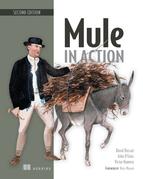List of Tables
Chapter 3. Working with connectors
Table 3.1. Configuring the file transport
Table 3.2. The HTTP transport lets you specify typical client-side properties.
Table 3.3. Common configuration properties for the JMS transport
Table 3.4. Common configuration properties of the IMAP transport
Table 3.5. Common configuration properties of the SMTP transport
Table 3.6. The FTP transport’s configuration, very similar to that of a typical FTP client
Table 3.7. Configuring the JDBC transport’s dataSource reference, pollingFrequency, and queryKey
Chapter 4. Transforming data with Mule
Table 4.1. Transformers for properties, flow variables, and session variables
Chapter 6. Working with components and patterns
Table 6.1. Available entry-point resolvers
Table 6.2. Variables made available to a scripting context
Table 6.3. Interfaces and annotations for the configuration of lifecycle methods
Chapter 8. Deploying Mule
Table 8.1. Pros and cons of the standalone server deployment option
Table 8.2. Pros and cons for embedding Mule in a web application
Table 8.3. Pros and cons for CloudHub deployment
Table 8.4. Pros and cons for embedding Mule in a standard Java application
Chapter 9. Exception handling and transaction management with Mule
Table 9.1. Available options for configuring a transaction action
Chapter 11. Tuning Mule
Table 11.1. Pros and cons of fully asynchronous mode
Table 11.2. Pros and cons of the synchronous-asynchronous mode
Table 11.3. Pros and cons of the fully synchronous mode
Table 11.4. Pros and cons of the asynchronous-synchronous mode
Chapter 12. Developing with Mule
Chapter 13. Writing custom cloud connectors and processors
Appendix A. Mule Expression Language
Table A.1. Properties of the server context object
Table A.2. Properties of the mule context object
Appendix B. Component and transformer annotations quick reference
